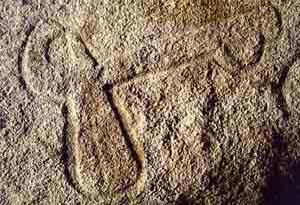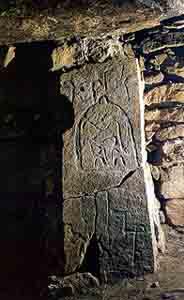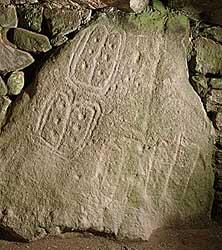- Home
- Megalithism in Morbihan
- Locmariaquer
- Megalithic art in Locmariaquer
- Introduction
- Carnac
- Gavrinis
-
Locmariaquer
- The peninsula and its monuments
- A cradle of archeological research
- Before the megaliths
- Grand-Menhir (Great Menhir)
- Er-Grah Tumulus
- La Table-des-Marchands (Merchants’s table)
- From Mané-Lud to Mané-er-Hroeg
- Pierres-plates (Flat Stones), a late tomb
- Megalithic art in Locmariaquer
- Locmariaquer, from Antiquity to the Middle Ages
- Le Petit-Mont
- Architectural types
Through just a handful of major monuments, the Locmariaquer peninsula provides a good overview of Armorican megalithic art.
The Mané-Lud dolmen contains a true digest of every type of passage tomb decoration:
- Here, the "shield" is an ogivalstele used as the floor-slab of the chamber, but this figure can also be found on the upright stone to the right of the entrance in the chamber passage;
- Roughly drawn " handled axes", as well as "crosiers", a circle of small cupmarks and "boats" with raised bows and sterns (possibly complete with their crew) can also be seen on this slab;
- At least 13 "horn-shaped figures" make up a real "sacred herd" on the penultimate upright stone on the left side of the passage;
- Finally, the chevet jambstone of the chamber displays a large enigmatic raised figure, possibly another shield-shaped slab reused to build the monument.
A series of horn-shaped figures on one of the slabs of the Mané-Lud.
In the "Table-des-Marchands" the showpiece is undoubtedly the white sandstone chevet jambstone, shining in the darkness of the tomb.
Its ogival shape is emphasized by a large "shield" in which the bilateral symmetry of the four series of "crosiers" is noticeable. The stone also carries other figures on its base and on the reverse side.
The ceiling of this monument is made up of the lower half of a large broken stele which, when reconstructed, displays a number of large superimposed figures. Today, these are distributed between the Table-des-Marchands and Gavrinis but they were originally designed to be admired and worshipped by all from a distance when the stone stood in open air : a great " axe-plough", two animal figures (probably oxen with overdeveloped horns), a "crosier" and a large "handled axe".
The wide handled-axe at the centre of the ceiling of the Table-des-Marchands.
Mané-Rutual, a long passage and double-chambered dolmen at the edge of the village, also shows examples of reused ornate steles:
- a great "shield" surmounted by what seems to be an axe head (now broken) on the lower face of the huge orthogneiss slab (11m long) which largely overlaps the main chamber;
- two " axe-ploughs " on two small steles, which were also reused in the structure of the monument for theantechamber;
- two small symmetrical "crosiers" on the base of an upright of the antechamber.
Only one ornate block was found in the great Mané-er-Hroeg tumulus, lying broken in the packing used to block off the burial-chamber entrance.
Though it is only 1.1m long, this stone is a major element of Armorican megalithic art thanks to its complex decoration, arranged around a central "shield":
- Inside, opposite crosiers and horn-shaped figures;
- On top and bottom end of the stone, a series of axes (almost all with crosier ends);
- Finally on the base, what is probably the broken figure of a small bovine figure.
The small stele of the Mané-er-Hroeg, reconstructed from the pieces found during excavation (and unfortunately broken by vandals…).
Pierres-plates, with its series of spectacular compositions, is a good example of that special art of Morbihan angled passage graves which gave rise to many interpretations.
The first upright, to the left of the entrance, shows a series of relatively simple figures including some carrying a raised beak, thus recalling the shield of passage graves.
The simplest idols of the Pierres-Plates recall the markings on the passage grave shields.



